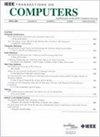An Efficient and Unified RTL Accelerator Design for HQC-128, HQC-192, and HQC-256
IF 3.8
2区 计算机科学
Q2 COMPUTER SCIENCE, HARDWARE & ARCHITECTURE
引用次数: 0
Abstract
In the Post-Quantum Standardization (PQC) process held by the National Institute of Standards and Technology (NIST), the final round of evaluation of the asymmetric cryptographic schemesHQC-128、HQC-192、HQC-256高效统一RTL加速器设计
在美国国家标准与技术研究院(NIST)举行的后量子标准化(PQC)过程中,对非对称加密方案Classic McEliece、BIKE和HQC的最后一轮评估将选出FIPS $203$标准CRYSTALS-Kyber的替代密钥建立机制(KEM)。在这项工作中,我们提出了HQC候选的RTL硬件设计的两种配置,要么是针对专门使用客户端-服务器风格协议的设备进行优化,要么是与所有KEM操作兼容的统一加速器,即密钥生成、封装和解封装。我们的设计与HQC规范定义的所有参数集兼容,根据运行时的选择提供相当于AES-128, AES-192和AES-256的安全余量。我们正在与PQC过程中方案的Artix-$7$ fpga的当前最先进的RTL硬件设计进行广泛的比较,引入一个新的指标来评估面积利用率,历史上这是由异构资源制成的此类设备的挑战性任务,并确定HQC在延迟,面积占用和效率方面迄今为止在基于代码的候选产品中具有最佳数据。当使用最低安全裕度的参数时,甚至可以与基于晶格的CRYSTALS-Kyber相媲美。
本文章由计算机程序翻译,如有差异,请以英文原文为准。
求助全文
约1分钟内获得全文
求助全文
来源期刊

IEEE Transactions on Computers
工程技术-工程:电子与电气
CiteScore
6.60
自引率
5.40%
发文量
199
审稿时长
6.0 months
期刊介绍:
The IEEE Transactions on Computers is a monthly publication with a wide distribution to researchers, developers, technical managers, and educators in the computer field. It publishes papers on research in areas of current interest to the readers. These areas include, but are not limited to, the following: a) computer organizations and architectures; b) operating systems, software systems, and communication protocols; c) real-time systems and embedded systems; d) digital devices, computer components, and interconnection networks; e) specification, design, prototyping, and testing methods and tools; f) performance, fault tolerance, reliability, security, and testability; g) case studies and experimental and theoretical evaluations; and h) new and important applications and trends.
 求助内容:
求助内容: 应助结果提醒方式:
应助结果提醒方式:


